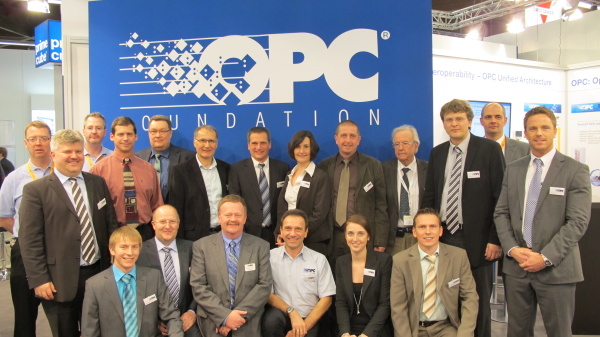News
MES and OPC UA connectivity
Erlangen October 2011. ascolab is a founding member of the MES Connectivity working group and editor of the companion specification. The OPC Foundation and MES vendors of the MES Dach group started a companion specification. This information model defines the OPC UA conformant representation of MES objects and information. The goal is to define a set of types in a dedicated MES namespace that are standardized and can be interpreted by MES systems using OPC UA communication when connected directly to the plant floor.OPC UA ported on iPhone
Erlangen, April 2011. ascolab was contracted to port the ANSI C OPC UA Stack on Apple operating system. The goal is to run OPC UA applications directly on iPhone and iPad devices. The OPC UA Stack was ported successfully and first client and server application testing was performed. This approach brings the industry prooven reliable and secure communication standard onto consumer electronic devices and opens up a large number of new applications and use cases.SPS/IPC/Drives 2010
Nuremberg November 23-25, 2010 ascolab GmbH showed OPC UA technology on the SPS/IPC/Drives. On the impressive new booth of the OPC Foundation (7-190) ascolab presented development and training services for OPC UA. The shared booth was designed under the head line "From Controller into the Cloud" and demonstrated the advantages of OPC UA communication in modern IT infrastructure. Visitors were invited to see live demonstration of PLC vendors and HMI/SCADA systems that are already OPC UA-enabled. The large team of exhibitors form different OPC member companies answered all questions around Unified Architecture and its application in the field.
ascolab GmbH showed OPC UA technology on the SPS/IPC/Drives. On the impressive new booth of the OPC Foundation (7-190) ascolab presented development and training services for OPC UA. The shared booth was designed under the head line "From Controller into the Cloud" and demonstrated the advantages of OPC UA communication in modern IT infrastructure. Visitors were invited to see live demonstration of PLC vendors and HMI/SCADA systems that are already OPC UA-enabled. The large team of exhibitors form different OPC member companies answered all questions around Unified Architecture and its application in the field.OPC UA on Security Essen 2010
Essen October 08, 2010 ascolab GmbH represented the OPC Foundation and showed OPC UA technology on the Security Essen. Many visitors and exhibitors already knew the classic OPC Standards, but learning about the new possibilities and flexibility of OPC Unified Architecture made them enthusiastic. High interest was shown in platform independence, secure communication especially for fire detection systems, access control systems, card readers, doors management and also the large area of video surveillance. This trade show revealed new opportunities and an emerging marked for OPC Unified Architecture not only for management and visualization systems also for device communication. Device description and diagnostic needs to be standardized analog to industrial automation components. Vendors and integrators agreed on a benefitial work force investigating how OPC UA can help them to create cost effectice solutions for their customers.
ascolab GmbH represented the OPC Foundation and showed OPC UA technology on the Security Essen. Many visitors and exhibitors already knew the classic OPC Standards, but learning about the new possibilities and flexibility of OPC Unified Architecture made them enthusiastic. High interest was shown in platform independence, secure communication especially for fire detection systems, access control systems, card readers, doors management and also the large area of video surveillance. This trade show revealed new opportunities and an emerging marked for OPC Unified Architecture not only for management and visualization systems also for device communication. Device description and diagnostic needs to be standardized analog to industrial automation components. Vendors and integrators agreed on a benefitial work force investigating how OPC UA can help them to create cost effectice solutions for their customers.COSMOS - EU Research Project
Cost-driven Adaptive Factory based on Modular Self-Contained Factory Units
Wind turbine manufacturing and aeronautics are two sectors where Europe is leading the world class competition. To guarantee this competitiveness in the future, productivity in the relevant manufacturing processes has to be improved. In the wind turbine manufacturing industry, assembly is one of the core processes in the full production chain. Most of these assembly operations are executed manually with the aid of different tools and gauges - the main disadvantages are a relatively high degree of variability, low process stability, the necessity to repeat certain tasks that are difficult to perform correctly first time and the generation of a high rework rate.
Objectives
The main objectives for COSMOS are the design, development and implementation of a distributed control system for the management of a factory with a flexible, modular and evolvable automation approach capable of increasing the assembly factory productivity by 20% without compromising on flexibility. Although the project will focus on the wind turbine assembly process, the conception of the solution will be suitable for other sectors including aeronautics and railway industries.
- Create a factory organisation concept based on intelligent factory units facilitating self-adaptation to changes in product/production on a flexible and modular automation configuration basis.
- Design and develop a distributed control system architecture, which will take into account the conceived factory unit organisation and its modular configuration, and, additionally, will be capable of synchronising different factory units.
- Design and develop the service layer infrastructure between the control system and the equipment/devices involved in the production activities. This service layer will enable:
- The interoperability with new devices in the modular factory units in a seamless, plug-and-use way, thus, facilitating the scalability of the solution.
- The integration of task-oriented, automated sub-systems as it is envisaged to be the case for a variety of complex assembly, testing and inspection operations.
- Define cost models to optimise the factoryunit configuration in terms of automation and modularisation. Such models will consider also the potential of adaptation capabilities with regards to new product demands.
Page 3 of 10



